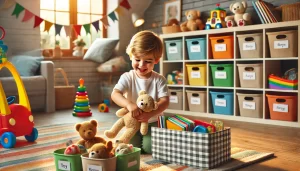Creating a well-organized study and play space at home is essential for a child’s development. A structured environment that encourages both learning and fun can improve focus, creativity, and overall well-being. The right setup helps children transition smoothly between activities, making it easier to balance structured learning with free play.
In this article, we will explore practical tips for designing an effective study and play area, discuss the importance of organization, and share expert-backed ideas to make the space engaging and functional.
Why Is an Organized Study and Play Space Important?
A thoughtfully arranged environment impacts a child’s ability to concentrate, explore, and retain information. When a space is cluttered or chaotic, children can become easily distracted, leading to frustration and reduced motivation. On the other hand, a well-structured space can:
✅ Promote independent learning and problem-solving
✅ Encourage creativity and imaginative play
✅ Reduce stress and overstimulation
✅ Improve time management and focus
✅ Create a sense of routine and discipline
By designing an inviting and practical learning environment, parents can foster a love for education while ensuring children have the freedom to explore and play.
Key Elements of an Effective Study and Play Area
Choose the Right Location
The ideal study and play area should be in a quiet part of the home, free from distractions like television and household noise. However, it should still be easily accessible so that parents can supervise when necessary.
Factors to Consider:
- Natural lighting: A well-lit space enhances mood and productivity.
- Accessibility: Materials and toys should be within reach for independent use.
- Noise level: Avoid high-traffic areas to minimize distractions.
🎯 Pro Tip: If space is limited, consider using a dedicated corner in a bedroom or living room.
Define Separate Zones for Learning and Play
Children thrive in environments that provide clear boundaries for different activities. Creating distinct areas for study and play helps reinforce structure and encourages focus.
How to Separate the Space:
📚 Study Zone: A small desk, comfortable chair, and good lighting for reading, writing, and creative tasks.
🎨 Creative Corner: Art supplies, a whiteboard, or a chalkboard for drawing and self-expression.
🧸 Play Area: A rug or playmat with bins for toys, puzzles, and games.
🎯 Pro Tip: Use colorful rugs, bookshelves, or furniture to visually separate different areas.
Keep It Organized with Storage Solutions
A clutter-free environment improves concentration and makes it easier for children to transition between activities.
Smart Storage Ideas:
- Bookshelves: Keep learning materials and books easily accessible.
- Storage Bins and Baskets: Label bins to categorize toys, crafts, and school supplies.
- Hanging Organizers: Utilize wall space for art supplies, flashcards, or small toys.
🎯 Pro Tip: Teach children to clean up after playtime by using a “10-minute tidy-up” routine.
Make the Space Engaging and Interactive
A study and play space should be inspiring and stimulating to keep children engaged.
Ways to Personalize the Space:
🌈 Use bright colors to create an inviting atmosphere.
📸 Add educational posters, maps, or motivational quotes.
🖍️ Display the child’s artwork to make the space feel personal.
🔤 Include alphabet charts, number boards, and puzzles for easy learning.
🎯 Pro Tip: Rotate toys and learning materials to keep the space fresh and exciting.
Incorporate Multi-Functional Furniture
If space is limited, using furniture that serves multiple purposes can maximize functionality.
Examples of Multi-Use Furniture:
- A desk with built-in storage for books and stationery.
- A foldable table for arts, crafts, and study time.
- A reading nook with storage ottomans for books and toys.
🎯 Pro Tip: Adjustable furniture allows the space to grow with the child.
Encouraging Independent Learning and Play
A well-organized space should encourage independence by allowing children to take control of their activities.
How to Foster Independence:
✅ Use open shelves so children can easily access and put away items.
✅ Offer self-directed learning activities like puzzles, books, and building blocks.
✅ Provide a visual schedule to help kids transition between study and playtime.
🎯 Pro Tip: Let children have input in organizing their space to increase ownership and responsibility.
Adapting the Space for Different Age Groups
👶 Toddlers (1-3 Years Old)
- Low shelves with soft toys and picture books
- A child-sized table and chairs for coloring or simple activities
- A sensory play bin with sand, rice, or water
🧒 Preschoolers (3-5 Years Old)
- Alphabet and number charts for early literacy skills
- Magnetic letters or flashcards for playful learning
- A dress-up corner for imaginative role-playing
👦 School-Age Children (5-7 Years Old)
- A designated reading area with a cozy chair and good lighting
- Writing and math workbooks for structured learning
- STEM toys like building blocks or science kits
🎯 Pro Tip: Adapt the space as children grow by updating learning materials and furniture.
Common Challenges and How to Overcome Them
“My child doesn’t want to use the study area.”
✔️ Solution: Involve them in decorating the space and choosing their supplies.
“There’s not enough space in my home for a study area.”
✔️ Solution: Use foldable desks, wall-mounted shelves, and multi-functional furniture.
“The play area is always messy.”
✔️ Solution: Use labeled storage bins and encourage a cleanup routine.
🎯 Pro Tip: Set a “clean-up song” to make tidying up more fun.
Final Thoughts
A well-organized study and play space at home is more than just an aesthetically pleasing area—it’s a foundation for learning, creativity, and growth. By creating an inviting, structured environment, parents can ensure that children remain engaged, focused, and excited about both learning and play.
A thoughtful setup encourages independence, reduces stress, and transforms everyday moments into meaningful learning experiences.




